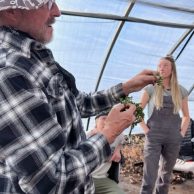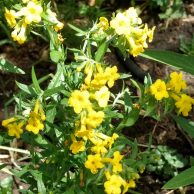
Gary Meis teaching
Last Saturday a group of dedicated plantspeople came in from the cold to learn and volunteer with Harlequin’s Gardens’ expert propagator Gary Meis. We’re passing a few of his native plant seeding and propagation tips along to you.
We Are Open for the Season!
Gift Memberships & Gift Certificates – available online!
See our seasonal hours and address, below.

Gary Meis teaching
Last Saturday a group of dedicated plantspeople came in from the cold to learn and volunteer with Harlequin’s Gardens’ expert propagator Gary Meis. We’re passing a few of his native plant seeding and propagation tips along to you.
 On our hikes, it seems we’re often exclaiming, “What a beautiful plant combination!”. Mother Nature’s inherent beauty and functional placement provide an amazing guide and inspiration for what we can create in our home garden or ecosystem. Mother Nature also helps guide us on how we can best support our pollinators.
On our hikes, it seems we’re often exclaiming, “What a beautiful plant combination!”. Mother Nature’s inherent beauty and functional placement provide an amazing guide and inspiration for what we can create in our home garden or ecosystem. Mother Nature also helps guide us on how we can best support our pollinators.
In the new Harvest 2020 issue of Colorado Gardener (with a striking mushroom cover photo!), Mikl writes in ‘Blooming Without a Care’ about a selection of wonderful lesser-known dryland native wildflowers that can also be very successful garden plants in our semi-arid climate. [Read More]

Hiking the West Ridge Trail on the Continental Divide
These are native plants that we often have for sale. Availability does change every year, but we grow and buy a wide variety of natives because they are so successful in our gardens.
KEY: t = tree, s = shrub, v = vine, gr = grass, gc = ground cover, p = perennial,
b = biennial, a = annual
Abronia fragrans (Sand Verbena) (p)
Acer glabrum (Rocky Mt. Maple) (t)
Acer grandidentatum (Bigtooth Maple) (t)
Achillea lanulosa (Native White Yarrow) (p)
Agastache cana (Hummingbird Mint) (p)
Agave parryi (Hardy Century Plant) (s)[Read More]
Whoever heard of Goji Berry 20 years ago? Now, with the current interest in superfoods, phytonutrients and antioxidants, Goji Berry juice and dried fruits can be found in many urban grocery stores. The 70+ species of Lycium are found on most continents and one species, Lycium pallidum, is native to Colorado. But the best known and most grown Goji is Lycium barbarum, the Chinese Wolfberry, also known as Matrimony Vine, Desert Thorn and Boxthorn. What is not commonly known is that this exotic superfood can be easily grown in Colorado.[Read More]
Curl-leaf Mt. Mahogany (Cercocarpus ledifolius)
This tall shrub or short tree is a beautiful broadleaf evergreen that is native to Colorado and much of the west up to 9000’. It’s narrow, curled leaves are an adaptation to reduce exposure to drying sun and wind; consequently it is very drought resistant, needing no irrigation after being established.The leaves are also thick, leathery, resinous and dark green above and pale below. Flowers are mostly inconspicuous and the fruit is only 1/4” long with a 2”-3” long silky tail. In dry weather these tails twist like a cork screw and with a little wind can be carried a good distance and then they will screw the seed right into the soil.[Read More]
Leave them to the Mountains OR Plant them at Home?
Populus tremuloides or Quaking Aspen is not only one of the best-known native trees here in Colorado, but it is said to be the most widely distributed tree of North America. Its narrow, roughly pyramidal form is commonly 25’-30’ tall and 15’-20’ wide, although it can get much larger. The leaves are shiny, dark green above and light gray-green beneath which makes the tree shimmer in the breezes. Also its whitish trunk adds to its attractive architecture. Then in the fall the leaves can turn a rich golden yellow which look glorious on the tree and lovely on the ground. It has a suckering habit which inclines it to clumps and which has put aspen in the running for the world’s largest being.[Read More]
Bigtooth Maple, Acer grandidentatum, is native to the far southwest corner of Colorado in a place known as Sleeping Ute Mountain. It is common in canyons, northfacing slopes and along mountain streams in Utah, Wyoming and west Texas from 5000′ to 8000′. Although most often listed as a separate species, Bigtooth Maple is sometimes called Western Sugar Maple, therefore, a subspecies of Acer saccharum. Its other names are Canyon Maple and Wasatch Maple.[Read More]
The Pinyon Pine has several advantages over other evergreen trees in a Colorado landscape. For one thing, its size doesn’t consume so much horizontal space. Compare the modest mature Pinyon at 10’-15’ in diameter with Austrian or Ponderosa at 25’-35’ diameter or Blue Spruce at 30’-40’ diameter. A few of these “average” sized evergreens look innocent when freshly planted, but who hasn’t seen them blocking sidewalks and doorways, tearing off gutters and shading solar collectors and windows in the winter? The Pinyon with its gently rounded top only gets 12’-20’ high, which suffices for many screening needs and still leaves the view. If it isn’t crowded, it stays branched to the ground with dense foliage of short, medium green to gray-green needles, two to a bundle. The cones are small 1 1/2”-2” long, brown to reddish-brown, which open to a rosette form and in the wild yield Pinyon “nuts”. These seeds are good-tasting and oily, with a piney flavor much appreciated by birds, animals and humans. They are also nutritious, being higher in protein and carbohydrates than pecans, but lower in fat. For some reason , these “nuts” are unlikely to develop in small urban plantings.[Read More]
Flood recovery is not a problem most of us have had to deal with before so we can only try to solve the problems individually and make adjustments in the future.
The main problems seem to be:
1) Soil washed away-erosion
2) Soil dumped on top of plants, trees and existing soil
3) Plants washed away
4) Weed seeds deposited on the soil 5) manure and sewage and unknown contaminants deposited on the land[Read More]
Saskatoon Serviceberry (Amelanchier alnifolia)
A winter-hardy (zone 4) native shrub of the Great Plains and Rocky Mountains. It has beautiful coarsely toothed leaves that are attractive even in the dry summer. The flowers are white and apple-like, fragrant and appear very early in the spring. Delicious blueberry-like fruit follow in midsummer. Birds are very fond of them and the American Indians used to mix these serviceberries with fat and buffalo meat to make their winter staple, pemmican. The Canadians have been working to develop this plant for fruit production.[Read More]
Hardy Geraniums are one of most versatile an adaptable perennials for our area. Available in many colors and habits, they can be useful in sun and shade, moist and dry, as a single specimen, as companion plants and as ground covers. These are not to be confused with the Pelargoniums which are the house plant, container and bedding plant “geraniums” which are not hardy outdoor plants in Colorado. The name “geranium” is derived from a Greek word meaning little crane, hens the common name “cranesbill” which refers to the appearance of the seed heads. The majority of the species of geraniums are native to the northern and mountain regions of Eurasia and North and South America although some are found in South Africa, India, Indonesia etc. Most grow in grasslands, meadows, roadsides and open woodlands. Therefore the natural habitat for most hardy geraniums seems to be sunny and moist or part-shade and moist or dry.[Read More]
Most of our native plains plants and shrubs including:
Sumacs
Penstemons
Rabbitbrushes
Desert Four O’Clock
Saltbrush
Heterotheca
Artemisias (Sages)
Thelesperma
Gambel Oak
Sulfur Flower (Eriogonums)[Read More]
There has been a lot of interest at our nursery, and in current plant-breeding programs for smaller shrubs. Most of the old-time favorite shrubs are very large. Most lilacs, viburnums, honeysuckles, forsythias, privets, elderberries, serviceberries, butterfly bushes and hibiscus are 6’-12’ high and often as wide. These are great to provide screening and big masses of color along fences or the back of the border.[Read More]
In our American communities, one of the responsibilities of home-ownership is to keep the ground covered. Bare earth, like weeds, indicates lack of care. So then, how do we cover the ground? The cheapest, fastest, and easiest way is to roll out bluegrass sod. “Instant” landscapes can be accomplished with a supervised construction crew that knows little about plants. And as long as water was plentiful, bluegrass was the unquestioned solution.[Read More]
Sign-up for our weekly e-newsletters to receive empowering gardening tips, ecological insights, and to keep up on happenings at Harlequin’s Gardens — such as flash sales and “just in” plants. We never share customer’s addresses!
Seasonally, MARCH to OCTOBER.
MARCH HOURS:
Thursday-Sunday, 9AM-5PM
APRIL-OCTOBER HOURS:
Tuesday-Sunday, 9AM-5PM
Mondays, CLOSED
